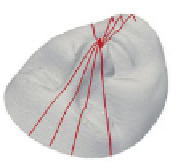Graphics Reference
In-Depth Information
Proposition 3.3.6
A parametrized curve has a unit-speed reparametrization if and only if it
is regular.
One can show that the arc-length is the only unit-speed parameter on a regular curve.
3.4 Facial Shape Representation Using Radial Curves
Let
with a reference radial curve.
The reference curve is chosen to be the vertical curve once the face has been rotated to the
upright position. In practice, each radial curve
β
α
denotes the radial curve on
S
, which makes an angle
α
β
α
is obtained by slicing the facial surface by a
plane
P
α
that has the nose tip as its origin and makes an angle,
, with the plane containing the
reference curve, as shown in Figure 3.3; that is, the intersection of
P
α
α
with
S
gives the radial
curve
β
α
. We repeat this step to extract radial curves from the facial surface at equal angular
separation. Each curve is indexed by the angle
α
. Figure 3.4 shows an example of some radial
curves.
If needed, we can approximately reconstruct
S
from these radial curves according to
as illustrated in Figures 3.4 and 3.5. This indexed collection of
radial curves captures the shape of a facial surface and forms its mathematical representation.
In practice, we used 80 curves.
We have chosen to represent a surface with a collection of curves because we have better
tools for elastically analyzing shapes of curves than we have for surfaces. More specifically,
we are going to utilize an elastic method for studying shapes of curves that is especially suited
for modelling deformations associated with changes in facial expressions.
S
≈∪
α
β
α
=∪
α
{
S
∩
P
α
}
3.5 Shape Space of Open Curves
In the last few years, many approaches have been developed to analyze shapes of 2D curves. We
can cite approaches based on Fourier descriptors, moments, or the median axis. More recent
works in this area consider a formal definition of shape spaces as a Riemannian manifold of
infinite dimension on which they can use the classic tools for statistical analysis. The recent
Collection of
radial curves
S
Nose tip
S
≈
Preprocessed face
r
α
Figure 3.3
is obtained by slicing the facial surface
by
P
α
defined by the angle
α
with the vertical plane and having as origin the nose tip. Copyright
C
Procedure for extraction of radial curves, a curve
β
2012, IEEE



















